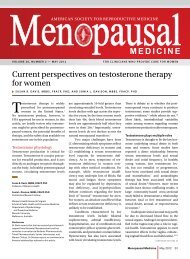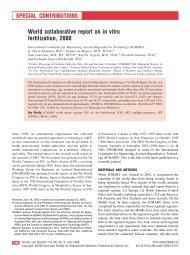scientific program • symposia - American Society for Reproductive ...
scientific program • symposia - American Society for Reproductive ...
scientific program • symposia - American Society for Reproductive ...
Create successful ePaper yourself
Turn your PDF publications into a flip-book with our unique Google optimized e-Paper software.
SCIENTIFIC PROGRAM <strong>•</strong> INTERACTIVE SESSIONS<br />
Monday, October 17, 2011 1:15 pm – 2:15 pm<br />
Interactive Session<br />
MANDATED STATE COVERAGE FOR FERTILITY:<br />
DOES IT PROVIDE EQUAL UTILIZATION?<br />
Presented by the Health Disparities Special Interest Group<br />
Gloria A. Richard-Davis, M.D. (Chair)<br />
Meharry Medical College<br />
David B. Seifer, M.D.<br />
Genesis Fertility & <strong>Reproductive</strong> Medicine<br />
G. Wright Bates, M.D.<br />
University of Alabama at Birmingham<br />
Needs Assessment and Description<br />
Infertility affects approximately 10% of all couples. Only 24%<br />
of employers provide any insurance coverage <strong>for</strong> fertility<br />
services. This coverage varies tremendously from evaluation<br />
only to treatment inclusive of assisted reproductive<br />
technology (ART). Most however, exclude any ART and<br />
still use justifications such as experimental treatment <strong>for</strong><br />
exclusion. There are a few states (approximately 14) that<br />
mandate coverage <strong>for</strong> fertility treatments. Additionally,<br />
there are multiple variations in what is mandated in the<br />
state initiatives or laws. For many patients, fertility service not<br />
covered by insurance means it is an unaf<strong>for</strong>dable option.<br />
What are the determinants of access to fertility services?<br />
Whether fertility services are covered or not potentially<br />
impacts access and outcomes <strong>for</strong> women across ethnic<br />
and socioeconomic strata. This interactive session will<br />
discuss the pros and cons of mandated coverage <strong>for</strong> fertility<br />
services.<br />
Room 224 G/H<br />
86<br />
Learning Objectives<br />
At the conclusion of this session, participants should be able<br />
to:<br />
1. Describe the impact of race/ethnicity upon success rates<br />
of ART.<br />
2. Describe the factors that could influence a woman’s<br />
choice of seeking ART <strong>for</strong> treatment of infertility.<br />
3. Discuss the challenges of achieving equal utilization of<br />
ART services <strong>for</strong> women of different races/ethnicities living<br />
in insurance-mandated states.<br />
ACGME COMPETENCY<br />
Systems-based Practice<br />
TEST QUESTION:<br />
Black women in the US have been experiencing:<br />
A. An increase in the prevalence in infertility at the same<br />
time infertility is increasing among white women.<br />
B. A decrease in the prevalence in infertility at the same<br />
time infertility is decreasing among white women.<br />
C. An increase in the prevalence in infertility at the same<br />
time infertility is decreasing among white women.<br />
D. A decrease in the prevalence in infertility at the same<br />
time infertility is increasing among white women.








